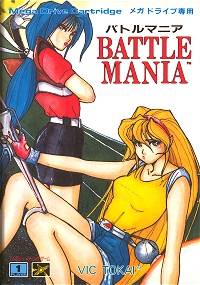Trouble Shooter
| Trouble Shooter | |
|---|---|
 Japanese cover art | |
| Developer(s) | Vic Tokai |
| Publisher(s) | Vic Tokai |
| Composer(s) | Hiroto Kanno |
| Platform(s) | Mega Drive/Genesis |
| Release | |
| Genre(s) | Shoot 'em up |
| Mode(s) | Single-player |
Trouble Shooter, known in Japan as Battle Mania (バトルマニア), is a scrolling shooter developed and published by Vic Tokai for the Mega Drive/Genesis in 1991. The game was given a very distinct theme of self-parody between the enemies, story and dialogue. A sequel titled Battle Mania Daiginjō (バトルマニア 大吟醸) was also released for the Mega Drive in Japan and Korea only.
Gameplay
A combat operative Madison is assigned to rescue a prince who has been taken hostage. Players assume control over Madison (Named Mania Ohtorii in the Japanese Battle Mania) who is accompanied at all times by her partner Crystal (Named Maria Haneda in the Japanese Battle Mania). Unlike Madison, Crystal can flip firing positions, allowing her to fire behind Madison, and is invulnerable to all enemy fire.
At the beginning of almost every stage, the players have to choose a special weapon they can use during combat. After every use, however, the weapon needs to recharge in order to be used again. Players can select from four different power-ups consisting of the usual shooter icons (speed-ups, life-ups, firepower and speed-downs). The player can stock up on Madison’s hit points by collecting life-up icons, which is necessary as the game has no lives system and only offers the player three continues.
Reception
Trouble Shooter was mostly highly positively received by critics, including being rated a perfect score of 25/25 by Doctor Dave from GamePro.[1] Les Ellis from Sega Pro gave it a more reserved review score of 73%, calling it "a rehash of Forgotten Worlds without all the great power-ups."[2] Retrospectively, Ken Horowitz from Sega-16 gave it an 8 out of 10, writing: "I can’t recommend Trouble Shooter enough. Shooter and action fans alike are sure to enjoy it, and it should be cheap enough to find with little trouble. Ignore the box and just enjoy the game for the great little shooter that it is."[3]
Sequel
Battle Mania Daiginjō is a horizontal side-scrolling shoot-'em-up published by Vic Tokai exclusively for the Sega Mega Drive on December 25, 1993. The graphics have been improved since the original Battle Mania (for example, the frames of each animation has been increased) and the game uses more anime styled art direction than its predecessor.
Battle Mania Daiginjou builds on the first release by introducing several improved features including tweaked weapon system where players now have more options to choose from for how they want to play the game. The game's pace has been significantly altered within the difficulty and the length of the stages. Uncommon to most shooter games, Daiginjō uses both vertical and horizontal scrolling for its stages. It has nine levels altogether, three more than its predecessor.
Unlike the first Battle Mania, it was not released in English, as it would have required too much editing which would lead to severely compromising the game experience given its deeper Japanese-centric flavor and emphasis on the game's heroines. Battle Mania Daiginjō is widely coveted by video game collectors and is one of the most expensive Sega Mega Drive games today. Vic Tokai had a limited print run of this title and it is very difficult to find in complete condition with box and instructions.[4]
References
- ^ GamePro 30 (January 1992), page 66.
- ^ "Out-of-Print Archive • Mega Drive reviews • Trouble Shooter". Outofprintarchive.com. Retrieved 2015-11-12.
- ^ "Sega-16 – Trouble Shooter". Sega-16.com. 2008-07-24. Retrieved 2015-11-12.
- ^ "The Rarest and Most Valuable Sega Genesis / Megadrive Games | RetroGaming with Racketboy". Racketboy.com. Retrieved 2015-11-12.
